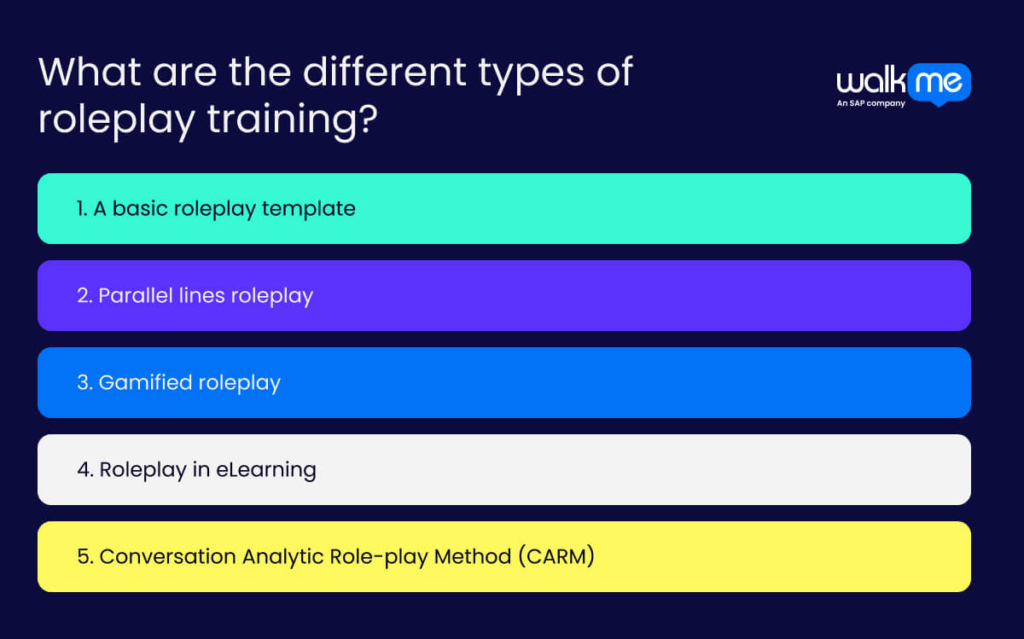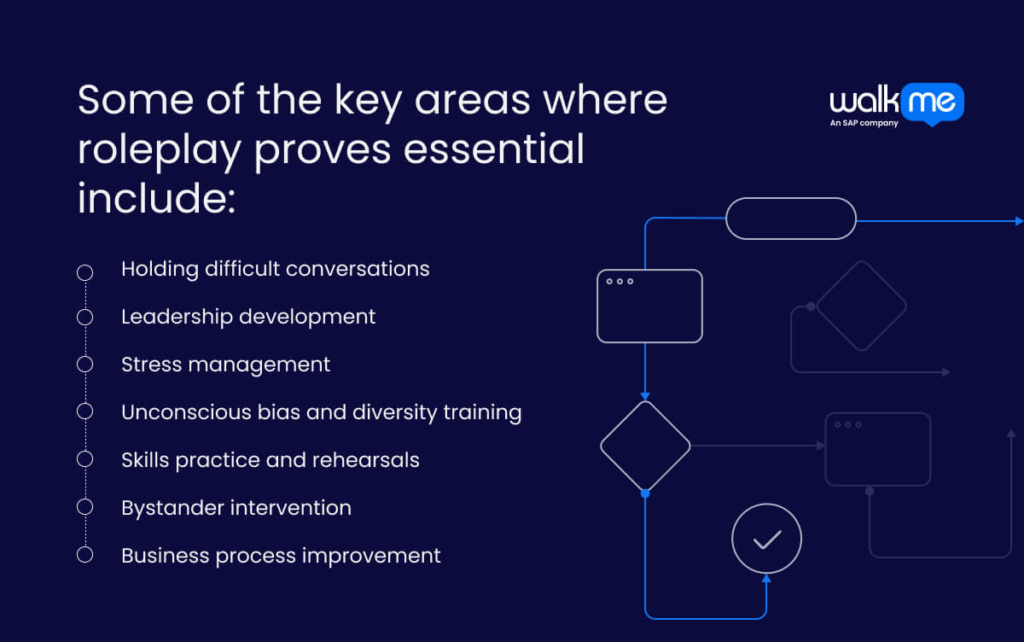Roleplay is a dynamic form of experiential learning and is a type of employee training.
With the right structure and guidance, employees engage in realistic scenarios, experiencing the challenges and emotions they’ll face on the job. In a risk-free environment, they refine their responses and improve vital soft skills like communication.
However, many employees dread roleplay. Poor facilitation leads to discomfort, disengagement, and resistance to change. Though, as you’ll discover, well-designed roleplay is highly effective.
This article will define roleplay training, explore proven methods, and highlight key applications. By the end, you’ll have the tools to make roleplay training engaging, practical, and valuable for your team.
What is roleplay training?
Roleplay training immerses participants in simulated scenarios to develop specific skills, behaviors, and techniques.
Employees take on assigned roles and engage in structured interactions guided by a facilitator. These exercises improve communication, problem-solving, and confidence in handling real-world challenges.
Commonly used in soft skills training, roleplay is also valuable in technical fields. Reflection, feedback, and evaluation help participants refine their approach and performance.
First popularized in the 1940s and widely adopted by the 1970s, roleplay remains a practical, cost-effective training method. Recent research highlights roleplay as a useful, adaptable, cost-effective training method. A recent Science Direct publication emphasizes its ease of implementation across industries, making it a versatile tool for leadership skill development.
What are the different types of roleplay training?

Roleplay is a simple idea with many different formats. This section will explain some varieties that can kickstart your roleplay training interventions.
We will look at:
- A basic roleplay template
- Parallel lines roleplay
- Gamified roleplay
- Roleplay in eLearning
- Conversation Analytic Role-play Method (CARM)
These techniques highlight the versatility and engagement of roleplay training. If you’re unsure how to integrate roleplay into your programs, one of these methods could be the perfect fit.
A basic roleplay template
Sometimes, all you need is the most simple type of roleplay. If that describes where you are, think about the following steps:
- Start by explaining the purpose of the roleplay and the specific skills participants will develop.
- Outline the scenario with relevant background details and clearly define each participant’s role.
- Give participants time to understand their roles and prepare the necessary materials.
- Conduct the roleplay with participants performing in front of the group or working in smaller sessions while the facilitator observes.
- Wrap up with a debriefing session, allowing participants to reflect, share insights, and take away key lessons for real-world application.
This basic employee training template has a lot of room for variation.
Parallel lines
“Parallel lines” is a great method for generating and sharing new ideas about how to deal with difficult situations.
- Pair participants and arrange them in two parallel lines facing each other. Each person should have a designated partner.
- Assign opposing roles to each line, clearly explaining their objectives and expected behaviors.
- Give participants time to immerse themselves in their roles before starting the role-play.
- Observe interactions closely, noting key behaviors and interventions. Afterward, facilitate a debrief where participants reflect on their experiences, discuss effective strategies, and explore real-world applications.
- Optionally, repeat the exercise with reversed roles for deeper learning.
The goal isn’t just for participants to immerse themselves in their roles—the debrief is just as important. It allows everyone to reflect, learn from different approaches, and understand alternative ways to handle the same situation. This discussion enhances learning by exposing participants to diverse perspectives and problem-solving strategies.
Gamified roleplay
Gamification may not seem like a direct line to business results. But in roleplay training, games can add a bit of fun that directly supports your training goals.
The following interventions work well:
- Warm-up games like charades or “Who Am I?” encourage participants to step into different personas, an important skill for more complex roleplay scenarios.
- Escape room activities are excellent for team building, with participants solving puzzles within a set time. Adding roleplay elements by assigning characters with unique abilities enhances collaboration.
- Large-scale simulation training can take on a game-like quality, especially when it mirrors real-world business scenarios. These simulations improve teamwork, problem-solving, and decision-making skills.
Gamified roleplaying is especially useful for team training exercises.
Roleplay in eLearning
Interactive eLearning can facilitate excellent roleplay experiences. Organizations with a large remote or hybrid workforce can use many established methods of combining these methods.
The following points summarize some of the key ideas:
- Asynchronous roleplay can be a great option for certain tasks. Unlike traditional workshops, it offers more control and flexibility in virtual environments.
- Leverage online platforms like Second Life, Facebook Metaverse, and VRChat to facilitate synchronous roleplay sessions, enhancing interactivity and engagement.
- When transitioning from in-person to online roleplay, thorough preparation is essential. Ensure your guidelines are clear, break-out rooms are set, and you’re ready to address potential technical issues.
- Online roleplay offers the advantage of easy self-reflection. Participants can record their sessions for review, allowing them to identify strengths and areas for improvement. Facilitators can also use recordings for future training plans.
Transitioning roleplay to an online format can seem overwhelming, but it offers numerous possibilities for effective learning. Since the release of The Power of Role-Based e-Learning in 2010, it’s been clear that roleplay and eLearning complement each other perfectly. Online platforms enable flexible, scalable training that can engage participants while providing valuable learning outcomes.
Conversation Analytic Role-Play Method
The Conversation Analytic Role-play Method (CARM) is an innovative approach from Elizabeth Stokoe, a London School of Economics researcher who developed CARM.
In a CARM workshop, participants do not act in their own roleplays. Instead, the session is based on recordings of real-life conversations in a relevant work area. The facilitator helps a group work through the recording very slowly: analyzing the speakers’ decisions, considering alternative discussions, and evaluating the success or failure of the interaction.
This method helps participants to understand the “landscape” of real-life conversations.
They can reflect on authentic speech and, in doing so, enhance their practice.
CARM is great for crisis negotiation, mediation, and sales calls.
What are the practical applications of roleplay training?
Roleplay training is highly versatile, making it effective for a wide range of situations. It offers valuable practice for real-life scenarios and can be applied across various business areas.
The power of roleplay lies in its ability to simulate realistic challenges, helping employees build practical skills and gain confidence.

Some of the key areas where roleplay proves essential include:
- Holding difficult conversations
- Leadership development
- Stress management
- Unconscious bias and diversity training
- Skills practice and rehearsals
- Bystander intervention
- Business process improvement
These areas highlight how roleplay goes beyond being a mere training tool; it’s a must-have in certain business contexts.
This section will focus on some business areas where roleplay is essential, not just a bonus.
Those are:
- Sales training (including negotiation)
- Customer service training
- Conflict resolution training
Before implementing roleplay training, it’s crucial to approach it thoughtfully. Many people dislike it due to social anxiety, past negative experiences, or simply not enjoying acting.
To ensure success, consider these best practices:
- Don’t overuse roleplay; it should be part of a balanced training mix.
- Listen to feedback and adapt your approach to fit participant preferences.
- Avoid pressuring individuals by allowing them to participate in ways they feel comfortable.
- Let participants script roleplays for later discussion if necessary to achieve key learning outcomes.
These considerations will help make roleplay training more effective and well-received.
Sales training
Sales roles demand effective communication, negotiation, and problem-solving. Roleplay allows professionals to practice these skills in a risk-free setting. It helps them try different approaches, receive feedback, and learn from both successes and failures.
Sales teams build confidence and refine techniques by simulating real-world sales scenarios—like meetings, handling objections, or product demos. Roleplay lets managers observe and assess team performance, providing valuable insights for targeted coaching. This enables both skill enhancement and the identification of areas requiring improvement.
Customer experience training
Customer experience representatives need skills like conflict resolution, soft skills, and product knowledge. Roleplay enhances these individually and shows how to combine them effectively.
Simulated customer scenarios allow employees to practice handling complaints, resolving conflicts, and offering support in a controlled setting with instant feedback. This training builds confidence, refines communication, and teaches empathy. Roleplay ensures that customer service teams are prepared to deliver exceptional service, improve customer relationship management, and contribute to business success.
Conflict resolution training
Conflict resolution involves communication, active listening, empathy, and problem-solving—skills that roleplay exercises can effectively enhance.
Here are some key scenarios for roleplay in conflict resolution training:
- Resolving disputes between colleagues
- Addressing conflicts with customers or clients
- Managing personal differences within teams
- Navigating difficult conversations
Using real-world conflict scenarios allows participants to engage deeply, exploring various perspectives. Facilitators can provide feedback, discuss strategies, and reflect on team dynamics.
Incorporating roleplay equips employees to handle conflicts, encouraging a positive, productive work environment.
Make a plan for successful roleplay training
Implementing roleplay training requires thoughtful planning to ensure effectiveness and engagement.
Recent studies highlight its effectiveness. For example, a Science Direct study revealed that role-playing leads to greater satisfaction and quicker skill development compared to traditional training methods.
Organizations can provide employees with opportunities to practice and refine essential skills in a supportive environment by designing roleplay scenarios that mirror real-life challenges.
This approach enhances learning outcomes and nurtures a positive attitude towards training initiatives. Embracing well-structured roleplay training can lead to measurable improvements in employee performance and satisfaction.
FAQs
To learn roleplay, practice by engaging in scenarios with others, focusing on immersing yourself in the role. Start with simple situations and gradually take on more complex scenarios. Observe others, receive feedback, and refine your communication and problem-solving skills through trial and error.
The four main types of roleplay are:
- Fictional: Imaginary scenarios used for creative or training purposes.
- Real-life: Simulates real-world situations like customer service or conflict resolution.
- Roleplay for skill development: Focuses on improving specific abilities, such as communication.
- Therapeutic: Used in therapy to address psychological issues.
Roleplay can lead to discomfort for participants, especially those with social anxiety. It may also feel forced or inauthentic if not executed properly. Some individuals may resist or disengage from roleplay exercises, leading to reduced effectiveness. Without careful facilitation, it can become repetitive or irrelevant.

